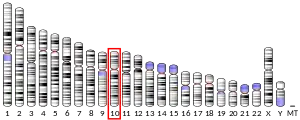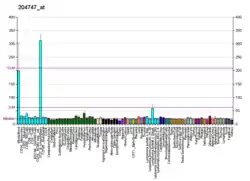Interferon-induced protein with tetratricopeptide repeats 3, also known as interferon-stimulated gene 49 (ISG49),[5] is a protein that in humans is encoded by the IFIT3 gene.[5][6][7][8] It plays a part in the innate immune response to viruses in response to type I interferon signaling.[5]
References
- 1 2 3 GRCh38: Ensembl release 89: ENSG00000119917 - Ensembl, May 2017
- 1 2 3 GRCm38: Ensembl release 89: ENSMUSG00000074896 - Ensembl, May 2017
- ↑ "Human PubMed Reference:". National Center for Biotechnology Information, U.S. National Library of Medicine.
- ↑ "Mouse PubMed Reference:". National Center for Biotechnology Information, U.S. National Library of Medicine.
- 1 2 3 Fensterl V, Wetzel JL, Ramachandran S, Ogino T, Stohlman SA, Bergmann CC, et al. (2012). "Interferon-induced Ifit2/ISG54 protects mice from lethal VSV neuropathogenesis". PLOS Pathogens. 8 (5): e1002712. doi:10.1371/journal.ppat.1002712. PMC 3355090. PMID 22615570.
- ↑ de Veer MJ, Sim H, Whisstock JC, Devenish RJ, Ralph SJ (December 1998). "IFI60/ISG60/IFIT4, a new member of the human IFI54/IFIT2 family of interferon-stimulated genes". Genomics. 54 (2): 267–277. doi:10.1006/geno.1998.5555. PMID 9828129.
- ↑ Zhu H, Cong JP, Shenk T (December 1997). "Use of differential display analysis to assess the effect of human cytomegalovirus infection on the accumulation of cellular RNAs: induction of interferon-responsive RNAs". Proceedings of the National Academy of Sciences of the United States of America. 94 (25): 13985–13990. Bibcode:1997PNAS...9413985Z. doi:10.1073/pnas.94.25.13985. PMC 28419. PMID 9391139.
- ↑ "Entrez Gene: IFIT3 interferon-induced protein with tetratricopeptide repeats 3".
Further reading
- Beausoleil SA, Villén J, Gerber SA, Rush J, Gygi SP (October 2006). "A probability-based approach for high-throughput protein phosphorylation analysis and site localization". Nature Biotechnology. 24 (10): 1285–1292. doi:10.1038/nbt1240. PMID 16964243. S2CID 14294292.
- Rual JF, Venkatesan K, Hao T, Hirozane-Kishikawa T, Dricot A, Li N, et al. (October 2005). "Towards a proteome-scale map of the human protein-protein interaction network". Nature. 437 (7062): 1173–1178. Bibcode:2005Natur.437.1173R. doi:10.1038/nature04209. PMID 16189514. S2CID 4427026.
- Reuter TY, Medhurst AL, Waisfisz Q, Zhi Y, Herterich S, Hoehn H, et al. (October 2003). "Yeast two-hybrid screens imply involvement of Fanconi anemia proteins in transcription regulation, cell signaling, oxidative metabolism, and cellular transport". Experimental Cell Research. 289 (2): 211–221. doi:10.1016/S0014-4827(03)00261-1. PMID 14499622.
- Izmailova E, Bertley FM, Huang Q, Makori N, Miller CJ, Young RA, Aldovini A (February 2003). "HIV-1 Tat reprograms immature dendritic cells to express chemoattractants for activated T cells and macrophages". Nature Medicine. 9 (2): 191–197. doi:10.1038/nm822. PMID 12539042. S2CID 26145639.
- Yu M, Tong JH, Mao M, Kan LX, Liu MM, Sun YW, et al. (July 1997). "Cloning of a gene (RIG-G) associated with retinoic acid-induced differentiation of acute promyelocytic leukemia cells and representing a new member of a family of interferon-stimulated genes". Proceedings of the National Academy of Sciences of the United States of America. 94 (14): 7406–7411. Bibcode:1997PNAS...94.7406Y. doi:10.1073/pnas.94.14.7406. PMC 23834. PMID 9207104.
This article is issued from Wikipedia. The text is licensed under Creative Commons - Attribution - Sharealike. Additional terms may apply for the media files.




